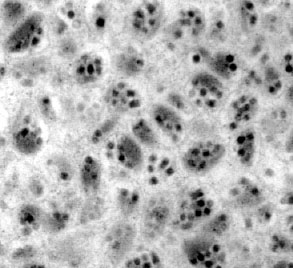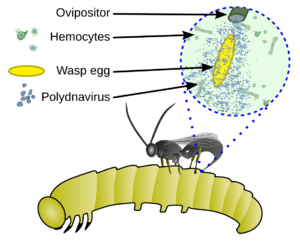Polydnavirus facts for kids
Quick facts for kids Polydnavirus |
|
|---|---|
 |
|
| Electron micrograph of a bracovirus | |
| Virus classification |
|
| (unranked): | Virus |
| Phylum: | incertae sedis |
| Class: | incertae sedis |
| Order: | incertae sedis |
| Family: | Polydnaviridae |
| Genera | |
|
Ichnovirus |
|
Polydnaviruses (PDV) are a special group of viruses that infect insects. There are two main types, called genera: ichnoviruses (IV) and bracoviruses (BV). Ichnoviruses are found in ichneumonid wasps. Bracoviruses are found in braconid wasps.
The virus's genetic material, called its genome, is made of many pieces of double-stranded DNA. These pieces are packed inside a protein shell called a capsid. The capsid is then covered by one or two layers. The genetic material of bracoviruses and ichnoviruses is quite different. This suggests they developed separately over time.
These viruses are part of a very unique natural system. This system involves three main parts: a parasitoid wasp, an insect larva (usually a lepidopteran caterpillar), and the virus itself. The full genetic code of the virus is actually part of the wasp's own genetic code. The virus only makes copies of itself in a specific part of the female wasp's ovaries. This happens when the wasp is a pupa or an adult.
When a female wasp lays an egg inside a host caterpillar, she also injects the virus. The virus then infects the caterpillar's cells. However, the virus does not make new copies of itself inside the caterpillar. Instead, it changes the caterpillar's immune system. Without the virus, the caterpillar's blood cells, called phagocytic haemocytes, would attack and kill the wasp egg.
The virus helps the wasp egg survive by weakening the caterpillar's immune system. This allows the wasp egg to hatch and grow inside the caterpillar. Also, genes from the polydnavirus change how the caterpillar grows and uses its energy. This makes the caterpillar a perfect place for the wasp larva to develop and survive. So, the virus and the wasp have a helpful partnership, known as a mutualistic or symbiotic relationship.
See also
 In Spanish: Polydnaviriformidae para niños
In Spanish: Polydnaviriformidae para niños


